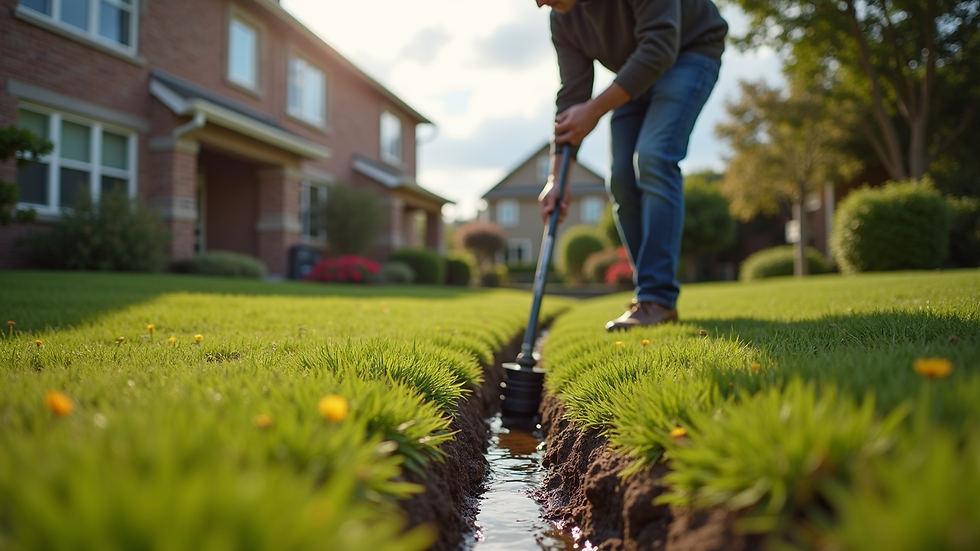Understanding the Basics of Proper Yard Grading
- Development Theory

- Jul 14
- 4 min read
Proper yard grading is essential for any property owner looking to maintain a healthy and attractive landscape. It might sound technical, but understanding yard grading isn’t as complicated as it seems. In this post, we’ll explore what yard grading is, why it’s important, and the basic principles that can turn your yard into a functional and aesthetically pleasing outdoor space.
What is Yard Grading?
Yard grading involves the process of leveling, sloping, or reshaping the soil in your yard to ensure proper drainage and aesthetics. Whether you’re preparing a new build or just improving an existing landscape, yard grading is crucial. The main goal is to direct water away from structures and create a pleasant environment for plants and outdoor gatherings.
Yard grading can involve raising or lowering soil in specific areas, creating slopes, or leveling out an uneven yard. When done correctly, it can enhance the beauty of your landscape.

Importance of Yard Grading
Yard grading serves multiple purposes. Here are several reasons why it’s essential for your property:
Water Drainage: Proper grading helps water drain away from your home and prevents flooding, which can lead to foundation damage. When water pools near your foundation, it could seep into your basement or crawl space, causing significant issues.
Erosion Control: Well-graded yards prevent soil erosion by promoting water runoff rather than saturation. This process protects your flower beds, grass, and any structures from being washed away.
Improved Aesthetics: A well-graded yard enhances the overall look of your landscape. It allows for better plant placement and a more appealing visual flow.
Increased Usability: Grading can create flatter areas for patios, walkways, and play areas, making your yard more functional and enjoyable for you and your family.
Preventing Pests: Standing water can attract pests like mosquitoes. Proper grading helps minimize these areas, making your yard healthier and more pleasant.
How to Assess Your Yard's Grading Needs
Before you begin any grading work, it’s important to assess your current yard situation. Here’s how you can evaluate your yard:
Observe Water Flow: After a rainstorm, take a look at how water flows across your property. Notice if there are areas where water collects or pools, particularly near your home and any existing structures.
Check for Sinking or Uneven Areas: Look for areas that are lower than others. These spots may be prone to water accumulation and should be filled in.
Inspect Existing Plants: Healthy plants can indicate good grading. If you notice certain plants thriving while others are struggling or rotting, consider adjusting your yard grading.
Use a Level: A simple tool like a level can help you identify slopes and uneven areas across your yard.
By taking these steps, you can better understand your yard's grading needs.

How Much Does It Cost to Grade a Yard?
The cost of grading a yard can vary widely based on several factors, including:
Size of the Yard: Generally, the larger the yard, the more it will cost to grade. Small to medium-sized yards may cost between $500 and $2,000, while larger properties could run up to $5,000 or more.
Type of Grading Required: Simple leveling may be less expensive than extensive grading that requires heavy machinery or significant earth moving.
Location: Costs may vary based on geographic location and access to your property. Urban areas typically have higher costs than rural settings.
Soil Condition: The type of soil and its condition can affect grading costs. Rocky or compacted soil may require more work.
Professional vs. DIY: Hiring a professional service can increase costs, but may save you time and ensure proper drainage. Many property owners choose to use professional yard grading services to avoid common pitfalls associated with improper grading.
It’s wise to get multiple quotes from grading companies to compare prices and services.

DIY Grading vs. Hiring a Professional
If you’re considering grading your yard, you may wonder whether to tackle the project yourself or hire professionals. Here are some insights into both options:
DIY Grading
Pros:
- Cost Savings: You can save money by not hiring labor.
- Flexibility: You can work on your own schedule.
- Learning Experience: It can be a great opportunity to learn more about landscaping.
Cons:
- Time-Consuming: DIY grading can take longer, especially without experience.
- Physical Labor: Grading involves significant manual labor, including shoveling and hauling dirt.
- Risk of Mistakes: Improper grading can lead to major issues like flooding and erosion.
Hiring a Professional
Pros:
- Expertise: Professionals have experience and can assess the best grading methods for your yard.
- Efficiency: They will likely finish the job faster due to their experience and equipment.
- Warranty: Many companies offer a guarantee on their work, giving you peace of mind.
Cons:
- Cost: Hiring a professional can be significantly more expensive than doing it yourself.
- Less Control: You may have less control over the design and execution of the grading.
Ultimately, the decision comes down to your budget, timeline, and the complexity of your grading needs. For many homeowners, leveraging professional skills is often the best way to ensure successful results.
Key Takeaways on Yard Grading
Understanding the basics of proper yard grading is essential for maintaining the health and aesthetics of your property. Proper grading can lead to better drainage, reduced erosion, and a more usable landscape. When approaching yard grading:
Assess your yard’s current conditions thoroughly before starting any work.
Do your research to decide whether to tackle the project yourself or hire a professional.
Keep costs in mind and plan accordingly.
Remember that proper grading is an investment in your home’s long-term value.
Taking the time to understand and implement proper yard grading techniques can make a significant difference in the health and appearance of your property. Whether you're planning to DIY or enlist professional help, the outcome is worth the effort!




Comentários